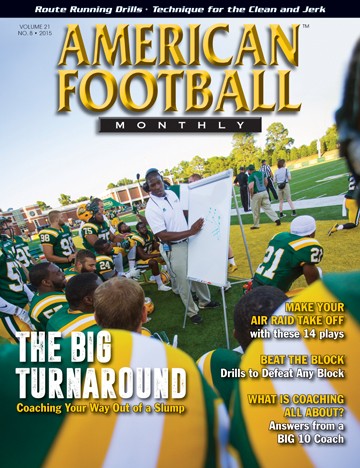Article CategoriesAFM Magazine
|
Leadership Strategies: Prima Donna Athletes – Transformational Leadership vs. Servant Leadershipby: Sean McCormickDefensive Coordinator Aiken High School (OH) © More from this issue Narcissus, a beautiful youth, glanced into a pool of water. Rejecting the nymph Echo, he fell in love with his own reflection. – Greek mythology Tying Greek mythology to football isn’t really a stretch, given the fact high school coaches are continually faced with one or more players who believe the team is there to serve them and not vice versa. Many coaches label these players as ‘cancers’. Unless, of course, they are clocked in the 40-yard dash under 4.5 or are of behemoth size and can run through the proverbial brick wall. No, these players are now described as rough around the edges or a work in progress. While the first type of narcissistic player believes he is much better and more important than his teammates, the other player with narcissistic tendencies knows he is better and really has no peers – at least athletically. Here’s the dilemma. How does a coach approach players with similar personality traits but with different skill sets? A 2011 article appearing in the Journal of Sport and Exercise Psychology, entitled “The Role of Athlete Narcissism in Moderating the Relationship Between Coaches Transformational Leader Behaviors and Athlete Motivation,” presented research which determined the narcissism levels of athletes had a direct effect on the success of transformational leadership methods used by coaches. Over 200 athletes, ages 13-19, rated 23 coaches from 12 sports. Each athlete spent an average of 1.2 years with their respective coaches. The coaches involved in the study were assessed on seven leadership behaviors, six of which were transitional in nature. The study concluded that those athletes who rated lower on the determined narcissism scale believed the coaching leadership inspired them to perform at a higher level. Concurrently, leadership inspiration tactics had less of a performance effect on athletes registering higher on the narcissism scale. Likewise, coaching efforts to boost team-oriented goals were more readily accepted by the ‘low narcissistic’ athletes. The description of the leadership style may conjure thoughts of a coach being ‘soft’ or getting the label of being a ‘player’s coach.’ Certainly, no one thought of Wooden as being soft on players. Wooden believed in being firm in ones beliefs and not deviating from those beliefs. However, Wooden also believed in listening to his followers to get the desired results. Kareem Abdul Jabbar, who played for Wooden at UCLA and had a great NBA career afterward, acknowledges Wooden’s ways helped him to turn failure into success by learning from mistakes. As Wooden himself said, “Ability may get your to the top, but it takes character to keep you there.” Today’s athletes are willing to work toward team success as long as they believe their personal reasons for playing are being met. Many coaches take themselves out of the equation by actions perceived by the player as not being helpful. For example, coaches whom have poor organizational skills or are visibly unable to handle coaching duties at critical times during a game are less likely to accomplish an overall ‘team’ focus. Likewise, coaches whom take the ‘bull by the horns,’ keeping instruction periods of practice/drills on schedule, creating open lines of communication (without boring players) and maintaining a level head during game ‘crunch times’ are more likely to steer even the most selfish-thinking athletes toward a team-first mentality. |
|
| HOME |
MAGAZINE |
SUBSCRIBE | ONLINE COLUMNISTS | COACHING VIDEOS |
Copyright 2024, AmericanFootballMonthly.com
All Rights Reserved




